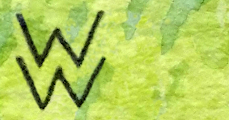
William Walkington was born in Kowloon, Hong Kong, in 1952. His father Ian (a Captain in the Royal Artillery) was English, and his mother Shelagh (a teacher née Munro) was Scottish. A year later, the Walkingtons returned to the United Kingdom and finally settled in Charlton Kings, Cheltenham, where William’s father Ian worked in GCHQ and William would go to Dean Close School.
Every summer holiday the family travelled north, and stayed at the Scottish family home, “Alderbrae,” in Tain. Living there were both William’s Aunt Rosemary Mackenzie MBE, a renowned local historian, and his Grandma Anna Winnifred Stuart Burnett Munro, a very skilful artist, affectionately known as "Winnie." The house was inspiring, not only because of its happy atmosphere and superb views, but also because it displayed art works that came from William’s Great-Grandfather Thomas Stuart Burnett A.R.S.A., an accomplished and prolific sculptor; and from his Great-Granduncle James Thwaite Irving, a talented artist who had painted with the Impressionists at Barbizon.
William’s Grandma Winnie had been a prize-winner at the Edinburgh College of Art, which she had entered in 1901. She had also exhibited regularly at the Royal Scottish Academy from 1908 to 1912. Skilled in many branches that included oil painting, etching, modelling, sculpture, architecture and design, she excelled in watercolours which she used more often. During William’s summer holidays, Winnie took him “under her wing,” and taught him how to paint, occasionally in oil, but most of the time in watercolours, with subjects ranging from still life to plein air scenes. Winnie’s unfailing sense of humour, and her kind and useful tips, were to influence William’s style throughout his life.
William finally chose to study architecture at the University of Nottingham, where, after his entry in 1971, he was admitted to the degree of Bachelor of Architecture (with Honours) in 1977. That same year he married Anne-Marie, a French girl, and after a short stay in Saint-Albans, Hertfordshire, they moved to France.
Between 1980 and 2013, William's French architectural career was to take him successively from Avranches in Normandy, to Paris, Lyon, Réunion Island, and then to Morlaix in Brittany. During those periods of travel and discovery, apart from practising his chosen profession, William also found the inspiration and time to paint. He began by creating a series of experimental 3D watercolours, and later he painted family portraits and various plein air views of the places that inspired him.
It was during a nine and a half year stay in Réunion Island, beginning in August 1995, that William was most productive. Particularly interested by the local métiers that were still accomplished by hard-working sugar cane cutters, and by fishermen who continued to use traditional wooden fishing boats, he endeavoured to immortalise these in watercolours, before they would disappear completely. The colourful vernacular architecture, the tropical vegetation and the mountainous scenery also incited him to create many watercolours, and his paintings were regularly chosen to illustrate locally-edited postcards. While a regular member of the “Union des Artistes de la Réunion” during this period, William not only participated in joint events with other artists, but also mounted several one-man exhibitions around the island. In addition to these activities he painted book cover illustrations for les “Editions Grand Océan.”
Returning to metropolitan France in January 2005, William began a new architectural practice in Morlaix, Finistère. There he was inspired by the beautiful coastal scenery of Brittany, and painted watercolours of the local fishing boats and seascapes. In 2013 William decided to retire and became a honorary architect.
He and Anne-Marie now live in Villedieu-les-Poêles, a small country town in Normandy. Besides indulging in the study of magic squares, which is another of his passions, William is inspired by the local bocages and the cows that graze in them, and likes to paint watercolours of these before they are completely overwhelmed by the current invasion of maize plantations. From time to time William visits his daughter Faye who lives in New Zealand, and he enjoys painting watercolour landscapes of its awe-inspiring sceneries. And as his son Scott now resides in Japan, it would not be surprising if William begins to paint Nippon scenes in a near future.
Recently, William has begun to experiment with paintings of science fiction, but whatever the subjects of his watercolours might be tomorrow, his style will always be influenced by the precious lessons he once learned from his first art teacher, Grandma Winnie!
